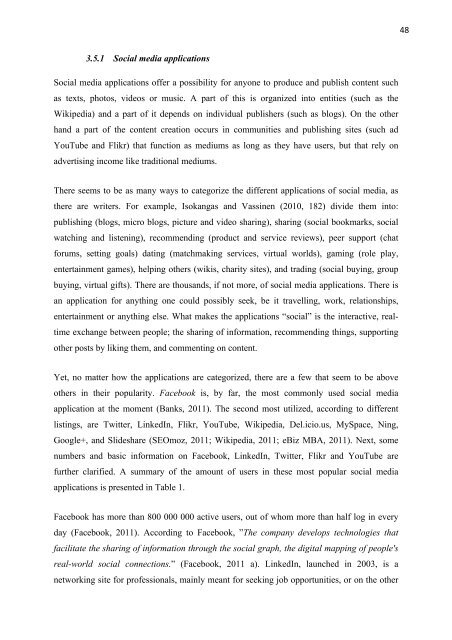Is there more to it than posting a status update?
Is there more to it than posting a status update?
Is there more to it than posting a status update?
You also want an ePaper? Increase the reach of your titles
YUMPU automatically turns print PDFs into web optimized ePapers that Google loves.
3.5.1 Social media applications<br />
Social media applications offer a possibil<strong>it</strong>y for anyone <strong>to</strong> produce and publish content such<br />
as texts, pho<strong>to</strong>s, videos or music. A part of this is organized in<strong>to</strong> ent<strong>it</strong>ies (such as the<br />
Wikipedia) and a part of <strong>it</strong> depends on individual publishers (such as blogs). On the other<br />
hand a part of the content creation occurs in commun<strong>it</strong>ies and publishing s<strong>it</strong>es (such ad<br />
YouTube and Flikr) that function as mediums as long as they have users, but that rely on<br />
advertising income like trad<strong>it</strong>ional mediums.<br />
There seems <strong>to</strong> be as many ways <strong>to</strong> categorize the different applications of social media, as<br />
<strong>there</strong> are wr<strong>it</strong>ers. For example, <strong>Is</strong>okangas and Vassinen (2010, 182) divide them in<strong>to</strong>:<br />
publishing (blogs, micro blogs, picture and video sharing), sharing (social bookmarks, social<br />
watching and listening), recommending (product and service reviews), peer support (chat<br />
forums, setting goals) dating (matchmaking services, virtual worlds), gaming (role play,<br />
entertainment games), helping others (wikis, char<strong>it</strong>y s<strong>it</strong>es), and trading (social buying, group<br />
buying, virtual gifts). There are thousands, if not <strong>more</strong>, of social media applications. There is<br />
an application for anything one could possibly seek, be <strong>it</strong> travelling, work, relationships,<br />
entertainment or anything else. What makes the applications “social” is the interactive, real-<br />
time exchange between people; the sharing of information, recommending things, supporting<br />
other posts by liking them, and commenting on content.<br />
Yet, no matter how the applications are categorized, <strong>there</strong> are a few that seem <strong>to</strong> be above<br />
others in their popular<strong>it</strong>y. Facebook is, by far, the most commonly used social media<br />
application at the moment (Banks, 2011). The second most utilized, according <strong>to</strong> different<br />
listings, are Tw<strong>it</strong>ter, LinkedIn, Flikr, YouTube, Wikipedia, Del.icio.us, MySpace, Ning,<br />
Google+, and Slideshare (SEOmoz, 2011; Wikipedia, 2011; eBiz MBA, 2011). Next, some<br />
numbers and basic information on Facebook, LinkedIn, Tw<strong>it</strong>ter, Flikr and YouTube are<br />
further clarified. A summary of the amount of users in these most popular social media<br />
applications is presented in Table 1.<br />
Facebook has <strong>more</strong> <strong>than</strong> 800 000 000 active users, out of whom <strong>more</strong> <strong>than</strong> half log in every<br />
day (Facebook, 2011). According <strong>to</strong> Facebook, ”The company develops technologies that<br />
facil<strong>it</strong>ate the sharing of information through the social graph, the dig<strong>it</strong>al mapping of people's<br />
real-world social connections.” (Facebook, 2011 a). LinkedIn, launched in 2003, is a<br />
networking s<strong>it</strong>e for professionals, mainly meant for seeking job opportun<strong>it</strong>ies, or on the other<br />
48















